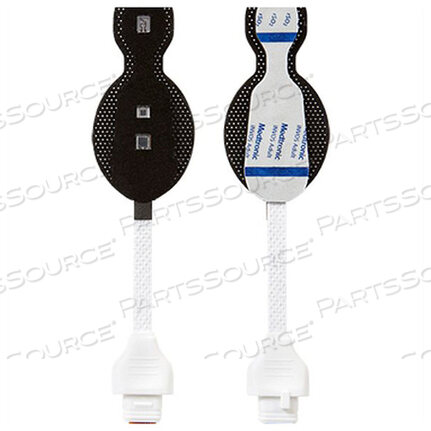ADULT SENSOR PMSENS71-A INVOS by Somanetics (Covidien)


OEM#: PMSENS71-A-20ADULT SENSOR PMSENS71-A INVOS by Somanetics (Covidien)
Adult sensors are used with the INVOS (In-Vivo Optical Spectroscopy) oximeter to noninvasively monitor site-specific adequacy of perfusion in the brain or body tissue directly beneath its sensors. This enables to obtain real-time data on regional oxygen saturation (rSO2), which can detect site-specific ischemic complications even when systemic parameters or lab tests are within normal limits. INVOS system adult sensors are applied to the skins surface and can be applied on up to four site-specific areas chosen by the care team. The sensors are user and patient friendly, making monitoring of ischemic threats to the brain and body safe and easy.
Adult sensors are used with the INVOS (In-Vivo Optical Spectroscopy) oximeter to noninvasively monitor site-specific adequacy of perfusion in the brain or body tissue directly beneath its sensors. This enables to obtain real-time data on regional oxygen saturation (rSO2), which can detect site-specific ischemic complications even when systemic parameters or lab tests are within normal limits. INVOS system adult sensors are applied to the skins surface and can be applied on up to four site-specific areas chosen by the care team. The sensors are user and patient friendly, making monitoring of ischemic threats to the brain and body safe and easy.
Adult sensors are used with the INVOS (In-Vivo Optical Spectroscopy) oximeter to noninvasively monitor site-specific adequacy of perfusion in the brain or body tissue directly beneath its sensors. This enables to obtain real-time data on regional oxygen saturation (rSO2), which can detect site-specific ischemic complications even when systemic parameters or lab tests are within normal limits. INVOS system adult sensors are applied to the skins surface and can be applied on up to four site-specific areas chosen by the care team. The sensors are user and patient friendly, making monitoring of ischemic threats to the brain and body safe and easy.
Adult sensors are used with the INVOS (In-Vivo Optical Spectroscopy) oximeter to noninvasively monitor site-specific adequacy of perfusion in the brain or body tissue directly beneath its sensors. This enables to obtain real-time data on regional oxygen saturation (rSO2), which can detect site-specific ischemic complications even when systemic parameters or lab tests are within normal limits. INVOS system adult sensors are applied to the skins surface and can be applied on up to four site-specific areas chosen by the care team. The sensors are user and patient friendly, making monitoring of ischemic threats to the brain and body safe and easy.
Adult sensors are used with the INVOS (In-Vivo Optical Spectroscopy) oximeter to noninvasively monitor site-specific adequacy of perfusion in the brain or body tissue directly beneath its sensors. This enables to obtain real-time data on regional oxygen saturation (rSO2), which can detect site-specific ischemic complications even when systemic parameters or lab tests are within normal limits. INVOS system adult sensors are applied to the skins surface and can be applied on up to four site-specific areas chosen by the care team. The sensors are user and patient friendly, making monitoring of ischemic threats to the brain and body safe and easy.
Adult sensors are used with the INVOS (In-Vivo Optical Spectroscopy) oximeter to noninvasively monitor site-specific adequacy of perfusion in the brain or body tissue directly beneath its sensors. This enables to obtain real-time data on regional oxygen saturation (rSO2), which can detect site-specific ischemic complications even when systemic parameters or lab tests are within normal limits. INVOS system adult sensors are applied to the skins surface and can be applied on up to four site-specific areas chosen by the care team. The sensors are user and patient friendly, making monitoring of ischemic threats to the brain and body safe and easy.
